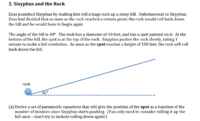Hi, I started off by writing the parametric equations as if the rock was rolling on a flat surface.
What I got by drawing sin/cos graphs and basing my answers off example problems:
x = 1t + 5sin(2πt)
y = 10 - 5cos(2πt)
x is horizontal distance, y is vertical distance, t is in minutes
Are these close to correct or helpful in solving the problem? I'm mainly not sure how to account for the incline or angle of the hill. I know that it'll change the y equation a lot. Should I be doing something like adding the 40 degrees into the parenthesis? Any help would be appreciated, thank you in advance.
What I got by drawing sin/cos graphs and basing my answers off example problems:
x = 1t + 5sin(2πt)
y = 10 - 5cos(2πt)
x is horizontal distance, y is vertical distance, t is in minutes
Are these close to correct or helpful in solving the problem? I'm mainly not sure how to account for the incline or angle of the hill. I know that it'll change the y equation a lot. Should I be doing something like adding the 40 degrees into the parenthesis? Any help would be appreciated, thank you in advance.

